The demand from a lawyer and, in fact, that from the profession has for long been limited to advocacy, the art of persuasion, communication, and analysis and interpretation of the law. However, the 21st-century shift in perspective and practice demands a “non-traditional” notion of lawyering. According to Richard Susskind (author of four books (The Future of Law (1996), Transforming the Law (2000), The End of Lawyers? (2008), Tomorrow’s Lawyers (2013)) that talk of the future of legal services), this ‘shift’ is primarily driven by liberalisation, the more-for-less challenge, and technology.
Liberalisation: Addressing the problem of closed legal communities and guilds, liberalisation permits setting up of ABAs (Alternate Business Structures), and external investments allowing non-lawyers to step into the legal field.
More-for-less challenge: This challenge highlights the phenomenon where clients are now less willing to spend on legal expenses, but expect more results.
Technology: We live in a world where technology influences our day-to-day lives. This makes it essential for the legal fraternity to adopt technology to improve processes and efficiency. Susskind calls for law practitioners to avoid “irrational objectivism”, which is the dismissal of the utility of AI and technology because one does not have any personal experience with the same.
Source: Richard Susskind, Tomorrow’s Lawyers, (2013)
What are the numbers saying?
A 2016 report on Legal Industry by Deloitte predicts “profound reforms” over the next decade. It projects a 39% loss in legal jobs, citing offset of newer jobs as the primary factor. Deloitte has also predicted that 1,00,000 legal roles will be automated by 2036 and law firms will start using new talent strategies by 2030.
| Legal Data Analytics | Legal Technology (Legal Tech) | Legal Design |
| Legal Operations | Legal Practice Management | Legal Talent Management |
| Legal Process Analyst | Legal Innovation and Solutions Architect | Online Dispute Resolution (ODR) Specialist |
| Legal Project Manager | Legal Knowledge Manager | Legal Risk Mitigation |
“One of law’s great challenges is to ensure that newly-minted and early-career attorneys possess basic practice skills — the ability to draft contracts and pleadings, interview a client, etc. But practice skills are no longer enough; lawyers must also understand the tools that drive more efficient delivery of legal services to clients/consumers — business fluency, understanding technology’s role in legal delivery, project management, basic data analytics, and an ability to collaborate, among others.”
Mark A Cohen (CEO of Legal Mosaic a legal business consultancy and Executive Chairman of the Digital Legal Exchange, a global not-for-profit organisation created to teach, apply, and scale digital principles to the legal function)
This raises two questions, “Who is a conventional lawyer?”, and “How has the role of a lawyer evolved?”
To answer these questions, we will explore the different kinds of skill sets demanded of a new-age lawyer that have been explained through different models such as the “T-shaped Lawyer”, “I-shaped Lawyer”, “O-shaped Lawyer”, and “Dynamic Delta Model of Lawyering”.
“Legal education and the legal profession are at an inflection point where traditional models of education and practice no longer fit the shifting needs of the market.“
Professor of Law, at Indiana University Maurer School of Law, and a pioneer in changing legal industry, who runs the Legal Evolution Blog
Who is a conventional lawyer?
By common observation, a conventional lawyer focuses on theoretical understanding and interpretation of the law to provide legal advice to the client. We earlier looked at the limited, and traditional aspects of the law such as analysis, research, communication, critique, and persuasion that are of primary importance to a conventional lawyer. In contrast, the new-age lawyer is expected to have a multi-disciplinary approach.
The conventional lawyer can be better understood through the I-shaped Lawyer model described below.
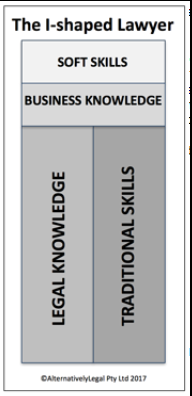
I-shaped Lawyers were 20th-century lawyers, with an in-depth understanding of their subject matter. They did not possess the hybrid ability to collaborate across disciplines and sectors, such as technology, business, innovation, data management, and security, etc. The letter ‘I’ is indicative of a single vertical line with no projections in any direction. This simply means that I-shaped professionals delve deep into their profession with a single-minded approach. Contemporary legal education curriculums across the globe, with a few exceptions, are only yielding I-shaped Lawyers.
How has the role of a lawyer evolved?
The expansion of skill sets was recognised in the 20th century. Below, we look at the various models of skill sets that a lawyer is expected to have.
The T-shaped Lawyer
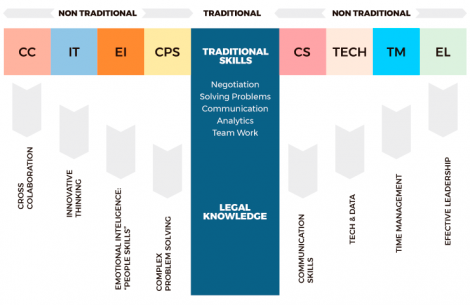
Introduced in 2014, by Amani Smathers, (Legal Technology Project Manager and Senior Practice Innovations Specialist at Chapman and Cutler LLP), a T-shaped Lawyer has multi-disciplinary knowledge, along with a broad and deep understanding of a specific area of practice. This makes T-shaped professionals specialised in their niche industry, and also adept with the intersection of other disciplines.
The shape “T”, can be divided into the top horizontal line and the bottom vertical line. In the representation of a lawyer, the top horizontal line signifies non-conventional skill sets. While the bottom vertical line signifies the depth and understanding of a niche area.
A vast-extending horizontal cap of the “T-shape”, can include, general technical knowledge, knowledge of legal design, understanding of project management, data science, process improvement, business partnership and leadership, risk management, etc.
The general argument is, that knowledge can better serve the interests of the conventional legal professional, who is slowly getting obsolete.
The O-Shaped Lawyer
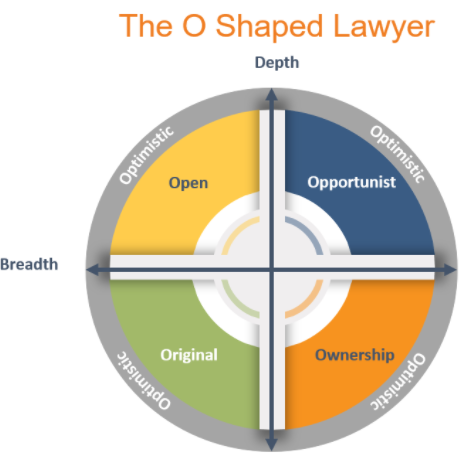
The O-shaped Lawyer Programme was founded in 2019 by a group of professionals in conventional and non-conventional roles. O-shaped Lawyers are more than a lawyer who is academically, technologically, and administratively prevalent. They are emotionally well-rounded. Hence, O-shaped Lawyers are driven by an emotionally intelligence. There are five tenets of the behavior and mindset of an O-shaped Lawyer:
- Optimism: O-shaped Lawyers are optimistic in their approach while working with a client. In times of crisis, they should be able to deliver with a progressive approach that benefits the client.
- Ownership: O-shaped Lawyers shall be trained to be more accountable for their results, while also taking responsibility for the client’s transaction. They should not just play the role of a lawyer but also that of an integral party to the transaction.
- Open-mindedness: O-shaped Lawyers are open-minded in their approach to law, legal transactions, client relationships, yielding results, etc. They are not averse to change and are willing to challenge their comfort zones.
- Opportunism: O-shaped Lawyers do not avoid risks. And are open to different, unexplored environments to seek opportunities.
- Original: Lastly, O-shaped Lawyers are original in finding creative solutions of their problems, instead of fixating on traditional, textbook solutions.
The Dynamic Delta Model
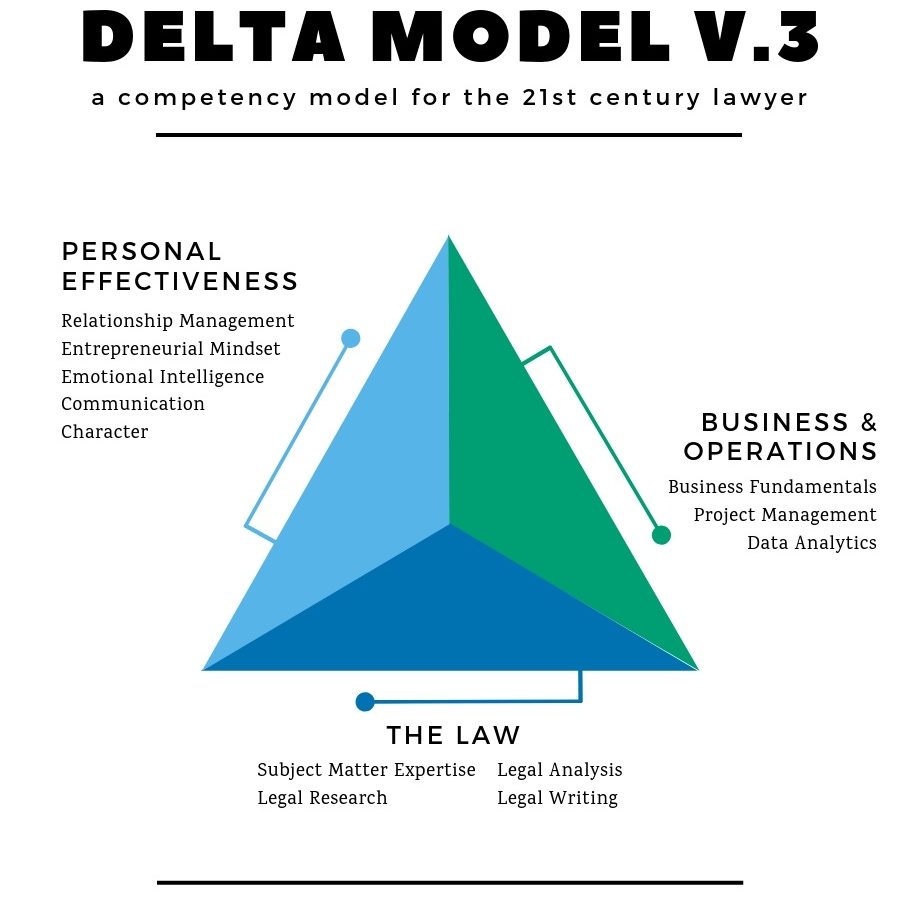
The Dynamic Delta Model is an ever-changing model of a holistic approach to lawyering that has four versions to date. It presents a model for a variety of legal careers, recognising allied professions in law. It values the interdependency of various skill-sets in a lawyer.
The idea of a Delta Model Lawyer was initially developed by Alyson Carrel (Legal Tech Educator at Northwestern Pritzker School of Law) and a group of other professionals.
While the I-shaped Lawyer incorporates legal skill and knowledge; and the T-shaped Lawyer incorporates a trans-disciplinary understanding. The Delta Lawyer also finds an area of alignment of social and self-awareness between oneself and the client.
Represented through a triangle, the three sides include the law, business and operations, and personal effectiveness.
Business and Operations Attributes
- Data Analytics
- Project Management and Work
- Technology: Understanding tools and when to use them
- Business Fundamentals
Law Attributes
- Subject Matter Expertise
- Legal Research
- Legal Analysis
- Legal Writing
- Legal Judgment
Personal Effectiveness Attributes
- Relationship Management
- Communication
- Emotional Intelligence
- Entrepreneurial Mindset
- Emotional Intelligence
- Character
The latest version (4.0), introduced in 2020, is an “Agile Competency Model for Modern Legal Professional” with three broad areas of distinction:
- The People (Understanding clients, relating to clients, colleagues, and themselves)
- The Process (Delivering legal services efficiently and effectively)
- The Practice (Knowing, researching and clearly communicating the law)
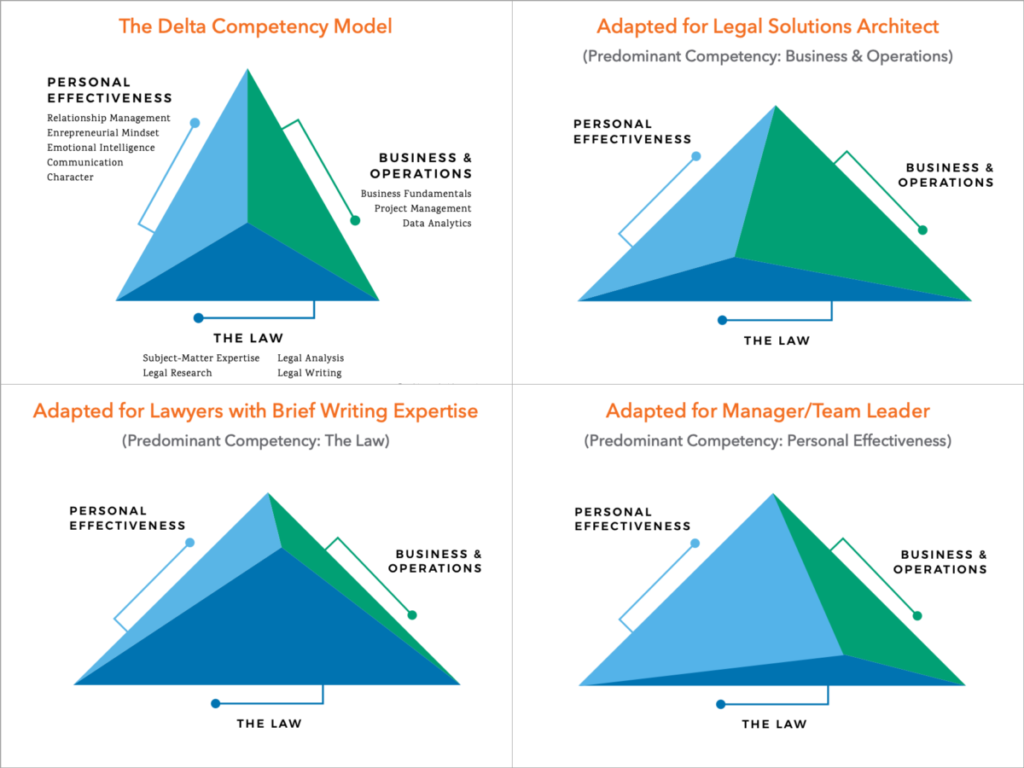
Source: Legal Evolution
The Delta Model aims to inculcate emotional intelligence and an entrepreneurial mindset, driven by practical skill set exposure. One can also choose an allied or alternate career path by shifting the midpoint of the triangle to increase or decrease the corresponding surface of a competency area. Eg: For a Law Clerk or Appellate Work, ‘The Practice’ area of the triangle would be wider. Whereas, for a Legal Operations Manager, “The Business and Operations” side of the triangle would be wider.
The Way Ahead
A need for institutional and administrative change in the conventional notion of a legal professional is evident with changing dynamics of technology and market expectations. To keep up with the change, lawyers must rethink their existing strategies and adapt to the newer skill sets.
Further Readings
- Richard Susskind, Tomorrow’s Lawyers, (2013)
- Natalie Runyon, Alyson Carrel, Cat Moon, Shellie Reid & Gabe Teninbaum, The Delta Model: simple, accurate, versatile, Legal Evolution
- Portrait of a 21st-century Lawyer, Version 2.0, Frontier of the Law
- Alyson Carrel, Legal Intelligence Through Artificial Intelligence Requires Emotional Intelligence: A New Competency Model for the 21st Century Legal Professional
- Mark A. Cohen, Goodbye Guild–Law’s Changing Culture, Forbes
- Mark A. Cohen, What’s a Lawyer Now?, Forbes
- Amani Smathers, The 21st Century T-shaped Lawyer
- Legal Tech Book Series, Tomorrow’s Lawyers By Richard Susskind, Legal Tech Blog

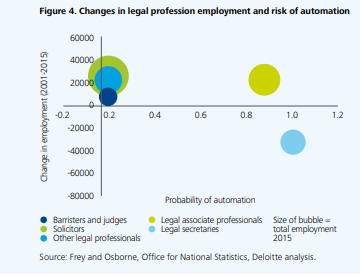
1 thought on “The Evolution of the Role of a Lawyer”